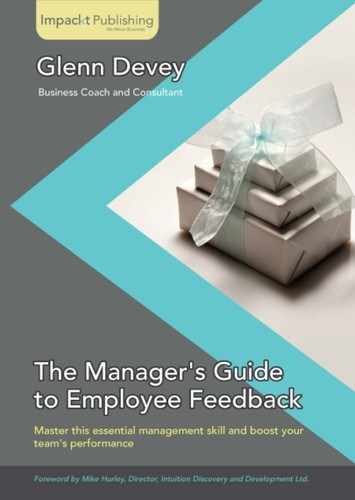- What went well
- Interesting aspects of performance
- Next time…
Let's take a look at the WIN model of feedback, which was derived from an Eastern European sports coaching model. It's a structure for emphasizing the positive aspects of someone's performance and also for suggesting areas of improvement. In that sense, it's a "balanced" model. Where some people have come unstuck using an approach like this is in trying to deliver a reprimand with it. If you need to have a purely corrective conversation with someone, use the DESC model in Chapter 4, Delivering a Reprimand. That model doesn't attempt to highlight positives at the same time!
Here's an opportunity to describe what someone has done that you want them to keep doing and, in fact, do more of. Of course, using the principles from Chapter 1, Feedback Fundamentals, you will ensure that they are within EARSHOT. You will need to evaluate your staff by both the end results that they deliver and also while they are "in flight" so to speak; going about their daily activities. In addition to any data reports you get about what they are delivering, shadow them in meetings that they attend and watch them as they speak to a customer or a group of colleagues. See how they go about their daily tasks and try to catch them doing something well! If you have the opportunity to solicit feedback from key customers or colleagues, then, done appropriately, this can prove to be a rich source of information from another perspective. Humans thrive on feedback and recognition, and positive acknowledgment works extremely well.
For example:
"You've delivered all three software specifications this month that we agreed on, and I noticed how many times you had to work outside core hours to do that. I appreciate that, and it has been commented on by my boss too."
"The presentation you gave to our prospective clients at the showcase used a really good case study about how we delivered a 20 percent cost reduction to Smith & Black. I'd encourage you to use something similar in the presentation you are currently writing."
"I see that the team's results from the last quarter are in, and sales figures are up by 11 percent on the same period last year. I'm really pleased about that. There's been a 31 percent increase in appointments made by the field sales team too, which has been instrumental in delivering that."
This part of the model invites the receiver to reflect on a part of their performance and come to their own conclusions about how they have performed. You're going to work within EARSHOT still, but leave them to decide for themselves about whether it was a good thing or not.
For example:
"What was interesting about the way that you conducted the interview with Mary Evans was the way in which you asked her to describe what she wanted her boss to be saying to her at her year-end review; I've not heard that question used before, where did you learn it from?"
"I was very intrigued by your approach to dealing with the irate customer who wrote and called us several times last week. You calmed them down within the first five minutes of taking the call by matching their voice tone and speed and then slowing them down gradually. How did you know it was time to take that approach?"
"I'm curious about how you managed to attend and repair fourteen appliance call-outs in two days… most technicians will do ten at the most. Tell me more about that…"
This section allows you to highlight things that need to be changed, still within the EARSHOT principles. Of course, you may need to describe an event that happened that was undesirable, but the key is to give a positive instruction to be followed next time instead of just mandating "Don't do it again."
For example:
"Next time there's a threat of disruptive action by the students, I want you to bring it directly to my attention after you've alerted site security."
"Next time you think you're not going to be able to meet an important client deadline, I want you to arrange for additional resources to be allocated to the task at least three days before it's due to be completed."
"Next time that you are stuck for ideas on a print layout, why not ask Jenny to take a look at it and give you some of her ideas?"
If you are new to both management and the WIN model, it may feel a little awkward the first time you run it through, which is perfectly natural. So, invest some time preparing for the conversation, but don't over-rehearse. There are a couple of things to bear in mind too: firstly, it is your responsibility and privilege to give feedback to staff, and secondly, you have earned the right to have this conversation due to your own performance and potential. Treat it like any other new skill, and anticipate that with time and practice it will become easier; which it will.
